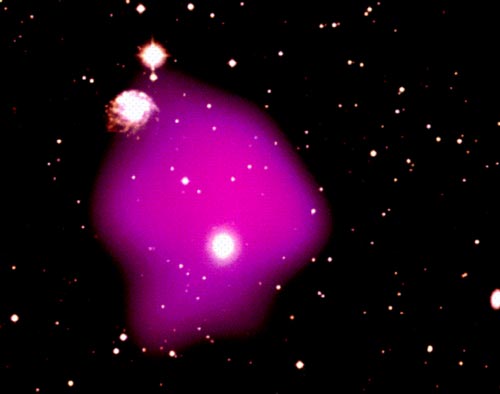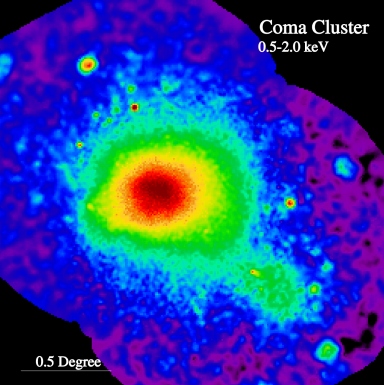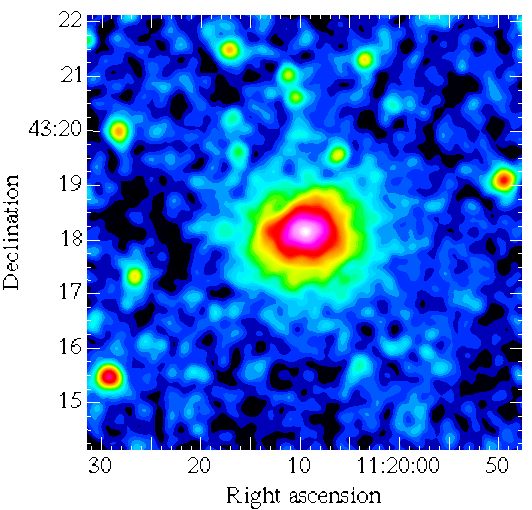In fact most of the binding mass of clusters of
galaxies is composed by
"dark matter" or "missing mass" that is detectable only through its
gravitational
effects on the luminous matter. The first evidence of the "dark matter"
has been found by Zwicky
(1933)
Using
X-ray observations, we can measure the masses of both the hot gas
and dark matter. The image on the right shows that the gravity exerted
on this group of galaxies observed with ROSAT exceeds all the
individual component galaxies combined.
The nature and the mass of this dark component is one of the biggest
mysteries in cosmology.
There are mainly two schools, a baryonic dark matter and a non-baryonic
dark matter school.
The baryonic schools claims, that the
"dark matter" is only ordinary mater (protons, neutrons and
electrons and atoms that we cannot detect through visible radiation)
which is actually missed from our census of the matter content of the
Universe, this could be either MACHOs (MAssive Compact Halo Objects),
white, red or brown dwarfs, planets, black holes, neutron stars, gas,
and dust.These MACHOs are potentially detectable by gravitational
lensing experiments, see this site on the EROS experiment
which objective is to search for the "MACHOs" in our Galaxy. Many have
been discovered through gravitational micro-lensing but not enough to
account for
"dark matter"
. From recent results of the
Wilkinson Microwave Anisotropy Probe we learned that only about
four percent of the universe is made up of baryonic matter, the
"normal" stuff we're familiar with and that's made of atoms with a
density of baryonic to an accuracy of better than 5% :
WB = 0.044+/-0.004 (with a Hubble constant h=0.71)
While the Non-baryonic school which is leaded by particle physists
suggest that the dark matter is composed by particles such as -
neutrinos, WIMPs or other Supersymmetric particles and axions.
In this framework, we call Cold Dark Matter (CDM) - a form of
non-baryonic dark matter with typical mass around 1 GeV/c2 (e.g.,
Weakly Interacting Massive Particles WIMPs) predicted by Supersymmetry
(SUSY). WIMPs would have been easily detected in acclerators if M <
15 GeV/c2 (e.g the Cryogenic Dark Matter Search CDMS). The lightest would be
stable and could still exist in the Universe, contributing most if not
all of the dark matter. The Hot (HDM) - a form of non-baryonic dark
matter with individual particle masses not more than 10-100 eV/c2
(e.g., neutrinos)
|

|
 The image on the right
shows Coma
cluster
image obtained with the ROSAT satellite.
Clusters of galaxies can be detected up to very high redshift.
One of such distant clusters
RXJ1120.1+4318 has recently been observed with XMM up to more than half its
virial radius. Such observations provides us with important information
on how galaxy clusters form and evolve and their number is a key
ingredient for the cosmological parameter determination.
The image on the right
shows Coma
cluster
image obtained with the ROSAT satellite.
Clusters of galaxies can be detected up to very high redshift.
One of such distant clusters
RXJ1120.1+4318 has recently been observed with XMM up to more than half its
virial radius. Such observations provides us with important information
on how galaxy clusters form and evolve and their number is a key
ingredient for the cosmological parameter determination. 
 RXJ1120.1+4318 at z = 0.6
RXJ1120.1+4318 at z = 0.6 
